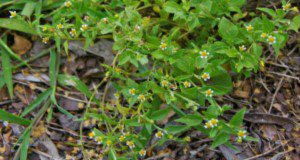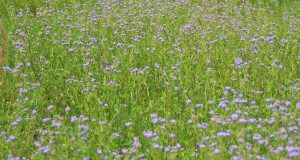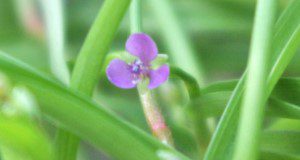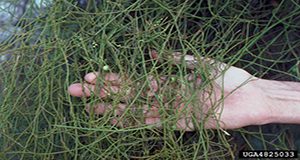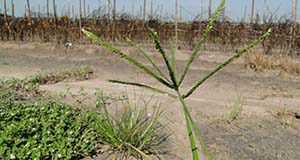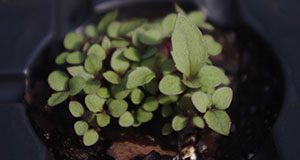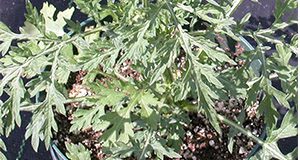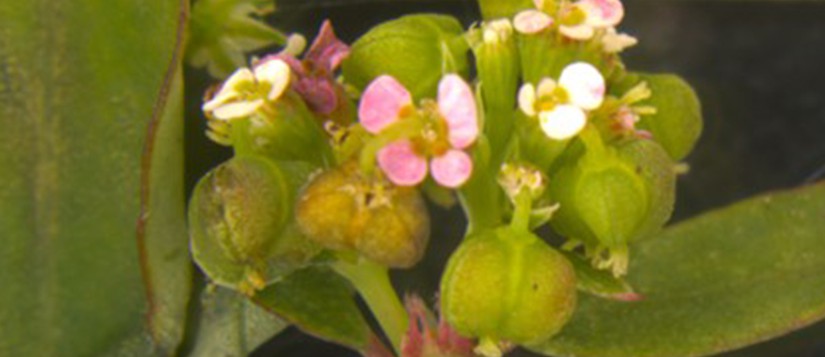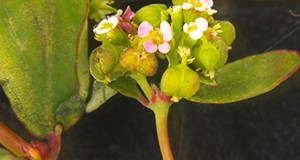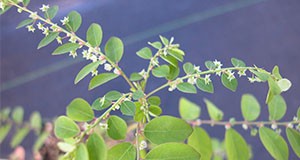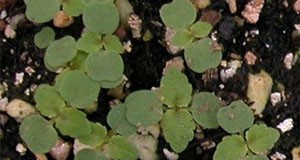Galinsoga (Galinsoga quadriradiata) is an erect (upright), herbaceous, short-lived warm-season annual weed in Florida landscapes, container nurseries, and other agricultural production systems. In nurseries and landscapes, galinsoga can be a troublesome weed, but it has been utilized by some cultures for food or medicinal purposes. This new 5-page article is written for green-industry professionals and others to aid in the identification and management of galinsoga in and around ornamental plants. Written by Thomas Smith, Chris Marble, Shawn Steed, and Nathan Boyd, and published by the UF/IFAS Environmental Horticulture Department.
https://edis.ifas.ufl.edu/ep593
Tag: Nursery Weeds
Biology and Management of Praxelis (Praxelis clematidea) in Ornamental Crop Production
Praxelis is a newly emerging weed species in Florida, one that Plant Protection and Quarantine (PPQ) is considering adding to the federal noxious weed list. The plant can be easily misidentified and confused with Ageratum houstonianum (bluemink) and Conoclinium coelestinum (blue mistflower) as well as several other species that have similar flower characteristics. This new 5-page article is written for green industry professionals and others to aid in the identification and management of praxelis in and around ornamental plants. Written by Yuvraj Khamare, Chris Marble, Shawn Steed, and Nathan Boyd, and published by the UF/IFAS Environmental Horticulture Department.
https://edis.ifas.ufl.edu/ep585
Biology and Management of Doveweed (Murdannia nudiflora) in Ornamental Crop Production
Doveweed is a common warm-season annual weed in Florida landscapes, container nurseries, and other agricultural production systems. This new 5-page article is written for green industry professionals and others to aid in the identification and management of doveweed in and around ornamental plants. Preemergence and postemergence herbicides are covered, as well as basic information on doveweed biology and growth. Written by Yuvraj Khamare, Chris Marble, Nathan Boyd, and Shawn Steed, and published by the UF/IFAS Environmental Horticulture Department.
https://edis.ifas.ufl.edu/ep576
Biology and Management of Dodder (Cuscuta spp.) in Ornamental Crop Production and Landscape
Dodder are a group of over 150 species in the genus Cuscuta. This 4-page publication was developed to help commercial growers, landscape professionals, and homeowners identify and manage dodder infestations in their greenhouses, nurseries, or landscapes. Written by Kaley Mierek, Chris Marble, Nathan Boyd, and Shawn Steed and published by the UF/IFAS Environmental Horticulture Department, May 2018.
http://edis.ifas.ufl.edu/ep556
Biology and Management of Goosegrass (Eleusine indica (L.) Gaertn.) in Ornamental Plant Production
This six-page fact sheet provides information about the biology and management of goosegrass, including preemergence and postemergence control options. Written by Shawn Steed, Christopher Marble, Nathan S. Boyd, Andrew MacRae, and Kiran Fnu and published by the Environmental Horticulture Department.
http://edis.ifas.ufl.edu/ep538
Biology and Management of Thickhead (Crassocephalum crepidioides) in Ornamental Crop Production
Typically found in shadehouses and shaded areas of nursery production, thickhead grows aggressively in containers and can outcompete nursery crops for water, nutrients, and light. This erect, sparingly branched, herbaceous annual, grows up to 4 feet tall and germinates over a wide range of pH, salt, and temperature conditions. This four-page fact sheet describes thickhead (Crassocephalum crepidioides) and various methods for its control in ornamental crop production. Written by Allison Bechtloff, Shawn Steed, Chris Marble, and Nathan Boyd and published by the Environmental Horticulture Department.
http://edis.ifas.ufl.edu/ep534
Herbicidas Postemergentes para Uso en Ornamentales

This is the Spanish language version of ENH95/WG095 Postemergent Herbicides for Use in Ornamentals http://edis.ifas.ufl.edu/wg059 Postemergent herbicides are applied directly to weeds. This 5-page fact sheet is largely comprised of two tables: Table one lists postemergent herbicides that can be safely used over the top of some ornamentals when used according to label directions; table 2 lists postemergent herbicides that are registered for use around ornamental plants when applied as a directed spray. Written by E. Vanesssa Campoverde, Chris Marble, and Jeffrey G. Norcini and published by the Environmental Horticulture Department.
http://edis.ifas.ufl.edu/ep533
Biology and Management of Ragweed Parthenium (Parthenium hysterophorous L.) in Ornamental Crop Production
This six-page fact sheet provides an overview of Ragweed Parthenium, Parthenium hysterophorous L, including a species description and information on how to manage ragweed parthenium culturally, physically, and chemically. Written by Debalina Saha, Chris Marble, Robert H. Stamps, and Shawn Steed and published by the Environmental Horticulture Department.
http://edis.ifas.ufl.edu/ep531
Weed Control for Ornamentals inside Greenhouses and Other Enclosed Structures
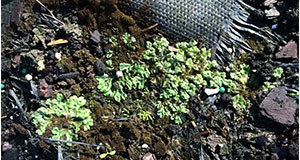
Maintaining a weed-free greenhouse is important for producing healthy and marketable crops. Weeds will compete with crops for water, light, and nutrients. Weeds can find favorable conditions for growth in gravel and along edges, tears, and worn areas of ground cloth. It is important to frequently scout for weeds. This five-page fact sheet describes both chemical methods of controlling weeds, but also non-chemical methods, such as sanitation and prevention, hand weeding, and cultural control practices. Written by Chris Marble and Jeremy Pickens, and published by the Environmental Horticulture Department.
http://edis.ifas.ufl.edu/ep528
Biology and Management of Graceful Sandmat (Chamaesyce hypericifolia) in Ornamental Crop Production
Graceful sandmat (Chamaesyce hypericifolia) is a problematic weed that often grows in container media in ornamental plant nurseries. This 4-page facts sheet profiles the biology of graceful sandmat and recommends physical, cultural, and chemicals methods for managing the weed in the nursery environment. Written by Theresa Chormanski, Chris Marble, and Lyn Gettys, and published by the UF Department of Environmental Horticulture, June 2015.
http://edis.ifas.ufl.edu/ep522
Biology and Management of Long-Stalked Phyllanthus in Ornamental Crop Production
This 5-page fact sheet discusses the characteristics of long-stalked phyllanthus and explains how to control its growth in a nursery environment. Written by Theresa Chormanski, Chris Marble, and Lyn Gettys, and published by the UF Department of Environmental Horticulture, April 2015.
http://edis.ifas.ufl.edu/ep518
Biology and Management of Mulberry Weed (Fatoua villosa) in Ornamental Crop Production
This 4-page fact sheet discusses the characteristics of mulberry weed (Fatoua villosa) and explains how to control its growth in a nursery environment. Written by Chris Marble and Shawn Steed, and published by the UF Department of Environmental Horticulture, April 2015.
http://edis.ifas.ufl.edu/ep517
Biology and Management of Oxalis (Oxalis stricta) in Ornamental Crop Production
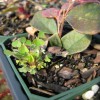 Oxalis grows throughout the year in Florida. It can be found growing in sidewalk cracks, alongside trails, in lawns, flower beds, cultivated fields, and in container nursery stock. In greenhouse studies, oxalis populations have been shown to negatively impact the growth rates of ornamental crops. This 6-page fact sheet was written by Matt Lollar and Chris Marble, and published by the UF Department of Environmental Horticulture, February 2015. (Photo: Chris Marble)
Oxalis grows throughout the year in Florida. It can be found growing in sidewalk cracks, alongside trails, in lawns, flower beds, cultivated fields, and in container nursery stock. In greenhouse studies, oxalis populations have been shown to negatively impact the growth rates of ornamental crops. This 6-page fact sheet was written by Matt Lollar and Chris Marble, and published by the UF Department of Environmental Horticulture, February 2015. (Photo: Chris Marble)
http://edis.ifas.ufl.edu/ep514
Biology and Management of Hairy Bittercress (Cardamine hirsute) in Ornamental Crop Production
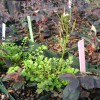 Bittercress commonly grows in the potting media of container-grown ornamentals and often through drainage holes in nursery containers. It also can be a problem in propagation houses, greenhouses, and in the field. This 6-page fact sheet provides species description, plant biology, and management recommendations. Written by Chris Marble, Shawn Steed, and Nathan S. Boyd, and published by the UF Department of Environmental Horticulture, December 2014.
Bittercress commonly grows in the potting media of container-grown ornamentals and often through drainage holes in nursery containers. It also can be a problem in propagation houses, greenhouses, and in the field. This 6-page fact sheet provides species description, plant biology, and management recommendations. Written by Chris Marble, Shawn Steed, and Nathan S. Boyd, and published by the UF Department of Environmental Horticulture, December 2014.
http://edis.ifas.ufl.edu/ep511
Postemergent Herbicides for Use In Ornamentals
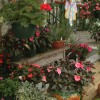 Postemergent herbicides are applied directly to weeds. This 5-page fact sheet is largely comprised of two tables: Table one lists postemergent herbicides that can be safely used over the top of some ornamentals when used according to label directions; table 2 lists postemergent herbicides that are registered for use around ornamental plants when applied as a directed spray. Written by Jeffrey G. Norcini and Chris Marble, and published by the UF Department of Environmental Horticulture, November 2014. (UF/IFAS photo: Thomas Wright)
Postemergent herbicides are applied directly to weeds. This 5-page fact sheet is largely comprised of two tables: Table one lists postemergent herbicides that can be safely used over the top of some ornamentals when used according to label directions; table 2 lists postemergent herbicides that are registered for use around ornamental plants when applied as a directed spray. Written by Jeffrey G. Norcini and Chris Marble, and published by the UF Department of Environmental Horticulture, November 2014. (UF/IFAS photo: Thomas Wright)
http://edis.ifas.ufl.edu/wg059
Uso Apropiado y Manipulacion de Glifosato en Viveros de Plantas (ENH1209/EP470)
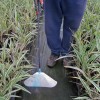 El glifosato es el químico de protección para cultivos más vendido en el mundo y el herbicida mós usado en la industria de viveros de plantas en los Estados Unidos. El glifosato es usado para el control post emergente de malezas. Esta publicación describe el uso adecuado de glifosato para los productores de plantas y sus empleados. This 4-page fact sheet was written by Shawn T. Steed, Robert H. Stamps, and Rodrigo Diaz, and published by the UF Department of Environmental Horticulture, February 2013.
El glifosato es el químico de protección para cultivos más vendido en el mundo y el herbicida mós usado en la industria de viveros de plantas en los Estados Unidos. El glifosato es usado para el control post emergente de malezas. Esta publicación describe el uso adecuado de glifosato para los productores de plantas y sus empleados. This 4-page fact sheet was written by Shawn T. Steed, Robert H. Stamps, and Rodrigo Diaz, and published by the UF Department of Environmental Horticulture, February 2013.
http://edis.ifas.ufl.edu/ep470
Alternatives to Synthetic Herbicides for Weed Management in Container Nurseries (ENH1203/EP464)
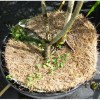 Weed management is one of the most critical and costly aspects of container nursery production. This is most effectively achieved through preventative practices, primarily with preemergent herbicides. But there are valid reasons for managing weeds with alternatives to synthetic herbicides, including sanitation, exclusion, prevention, hand weeding, mulching, and the use of cover crops, heat, and nonsynthetic herbicides. This 6-page fact sheet was written by Gary W. Knox, Matthew Chappell, and Robert H. Stamps, and published by the UF Department of Environmental Horticulture, September 2012.
Weed management is one of the most critical and costly aspects of container nursery production. This is most effectively achieved through preventative practices, primarily with preemergent herbicides. But there are valid reasons for managing weeds with alternatives to synthetic herbicides, including sanitation, exclusion, prevention, hand weeding, mulching, and the use of cover crops, heat, and nonsynthetic herbicides. This 6-page fact sheet was written by Gary W. Knox, Matthew Chappell, and Robert H. Stamps, and published by the UF Department of Environmental Horticulture, September 2012.
http://edis.ifas.ufl.edu/ep464
Proper Use and Handling of Glyphosate in Plant Nurseries (ENH1198/EP459)
 Glyphosate is the most used herbicide in the nursery industry in the United States. Used for postemergent control of vegetation, it controls annual and perennial grasses, broadleaves, and sedges. But it is easy to cause unintended damage to desirable vegetation if this product is used incorrectly. This 4-page fact sheet outlines the proper use of glyphosate for plant producers and their employees. Written by Shawn T. Steed and Robert H. Stamps and published by the UF Department of Environmental Horticulture, May 2012.
Glyphosate is the most used herbicide in the nursery industry in the United States. Used for postemergent control of vegetation, it controls annual and perennial grasses, broadleaves, and sedges. But it is easy to cause unintended damage to desirable vegetation if this product is used incorrectly. This 4-page fact sheet outlines the proper use of glyphosate for plant producers and their employees. Written by Shawn T. Steed and Robert H. Stamps and published by the UF Department of Environmental Horticulture, May 2012.
http://edis.ifas.ufl.edu/ep459
Preemergence Herbicides for Use in Ornamentals (OH94/WG058)
 Preemergence herbicides are herbicides that are applied prior to weed seed germination. Control of weeds using preemergence herbicides is most successful when the correct herbicide is applied in the correct manner to a weed-free growing medium prior to weed seed germination. This 60-page fact sheet was written by Robert H. Stamps, Heidi M. Savage, Diane K. Rock, and Jeffrey G. Norcini, and published by the UF Department of Environmental Horticulture, March 2012.
Preemergence herbicides are herbicides that are applied prior to weed seed germination. Control of weeds using preemergence herbicides is most successful when the correct herbicide is applied in the correct manner to a weed-free growing medium prior to weed seed germination. This 60-page fact sheet was written by Robert H. Stamps, Heidi M. Savage, Diane K. Rock, and Jeffrey G. Norcini, and published by the UF Department of Environmental Horticulture, March 2012.
http://edis.ifas.ufl.edu/wg058
Prevention, Early Detection, and Eradication of Benghal Dayflower in Field Nurseries (ENH1085/EP350)
Benghal dayflower is an increasingly problematic weed that is federally designated as a noxious weed. This 10-page fact sheet provides nursery owners how to prevent, detect, and eradicate this invasive plant. Written by Robert Stamps, and published by the UF Department of Environmental Horticulture, May 2011.
http://edis.ifas.ufl.edu/ep350
